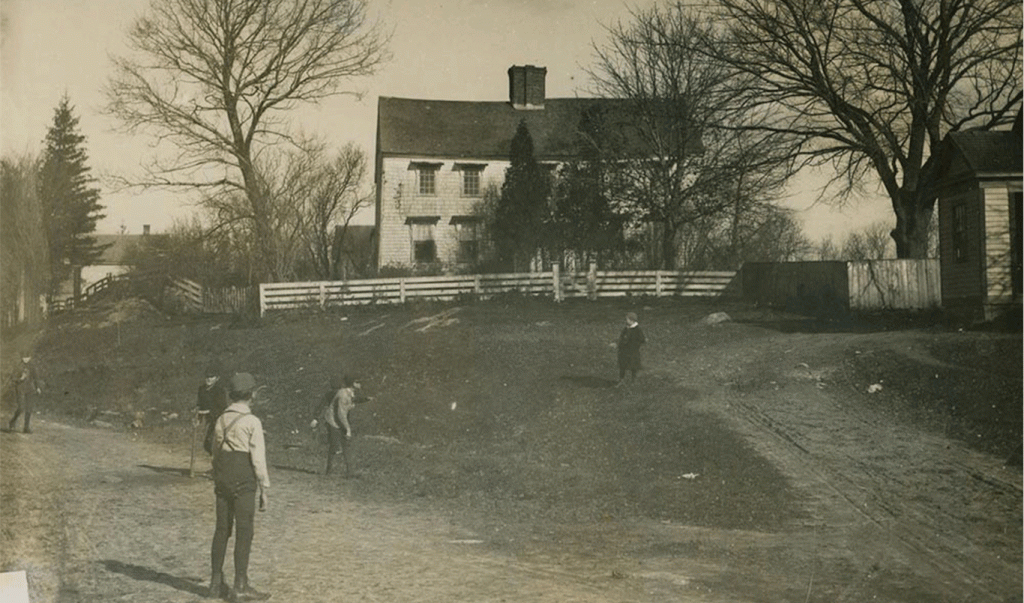
by Carolyn Wakeman
Featured Image: Female Reading Society notebook, 1816. Lyme Historical Society Archives
A simple hand-stitched notebook, its marbled paper cover faded over the centuries, records the religious, educational, and charitable purposes of Lyme’s earliest women’s organization. Mid-way through the construction of a new Meetinghouse at the foot of what is now Lyme Street, ten ladies from the town’s prominent families gathered in 1816 to establish a reading group.
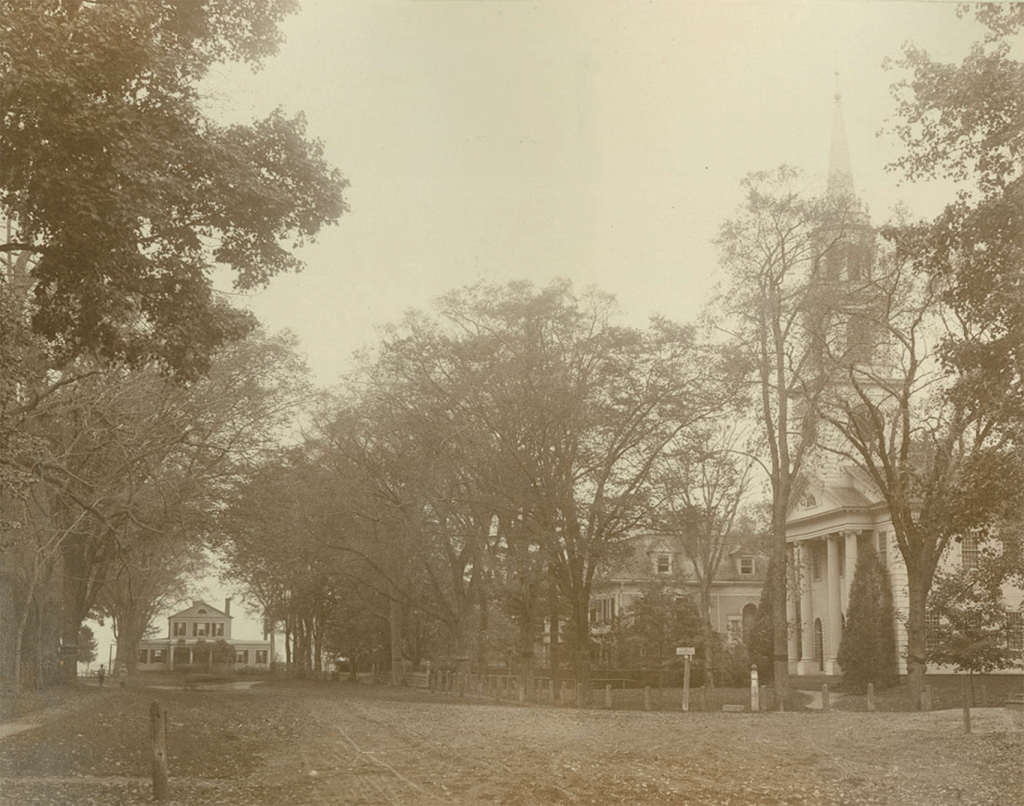
First Congregational Church at the foot of Lyme Street, ca. 1895. LHSA
At the initial meeting of the Female Reading Society, the minister of the First Congregational Church offered “an appropriate prayer” and provided a letter of guidance. “I trust you have been moved by the Spirit to associate together for the pious & commendable purpose of reading the Scriptures,” Rev. Lathrop Rockwell (1769–1828) wrote. Gathered in Mrs. Phoebe Lord’s (1768–1841) parlor on what was then the stagecoach route through town, the women elected officers and adopted a constitution defining the Society’s goals, dues, and membership requirements. Half of its annual income “would be given in charity to the poor of this parish, the other half to the missionary cause.” Any woman “who bears a good moral character and pays 2½ cts” could join.[1]
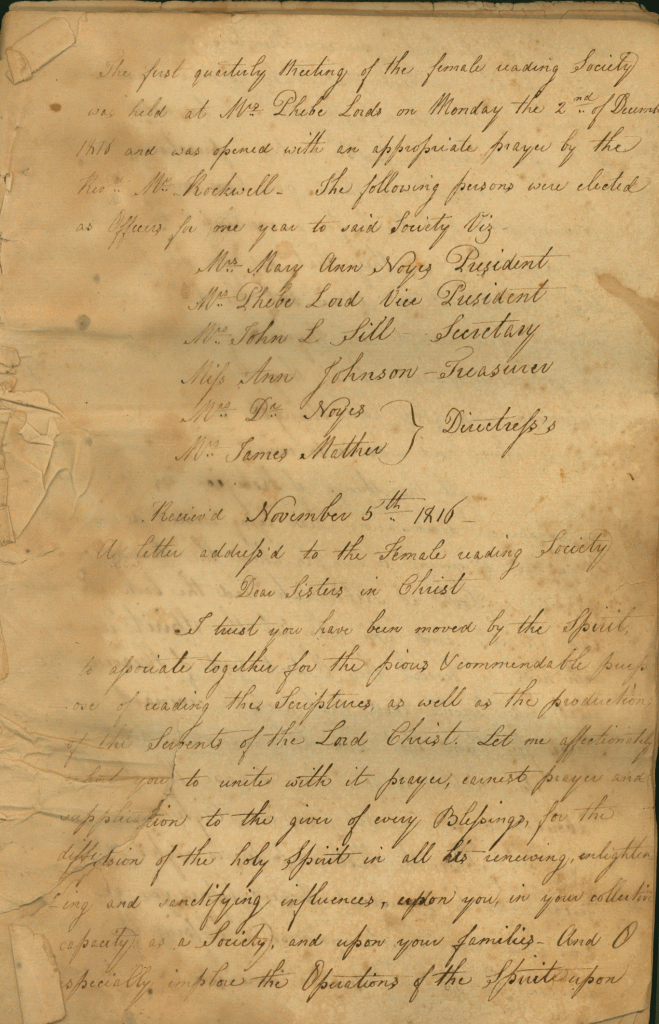
Elected officers, Female Reading Society, 1816. LHSA
The Society provided an opportunity for a circle of close neighbors and friends to direct their own religious education and deepen their personal piety through devotional reading. But it also created a separate women’s space in which widows, wives, and daughters from propertied families acquired a voice and a vote. Apart from their husbands and households, this group of privileged Lyme women acquired a new and enduring autonomy. Their weekly gatherings also set aside a time, initially on Sabbath evenings, for socializing in Lyme’s most gracious parlors.
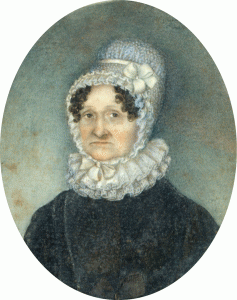
Phoebe Griffin Lord Noyes, miniature portrait of her mother Phoebe Lord, ca. 1828. Watercolor on paper. LHSA
Home of Mrs. Phoebe Lord, ca. 1885. LHSA
Between 1817 and 1819 Abigail Noyes Sill (1786–1883), the group’s secretary, and Hannah Townsend Noyes (1789–1856), one of its directors, hosted meetings in their elegant new homes, known today as the Lyme Academy of Art, and the Florence Griswold Museum.[2]
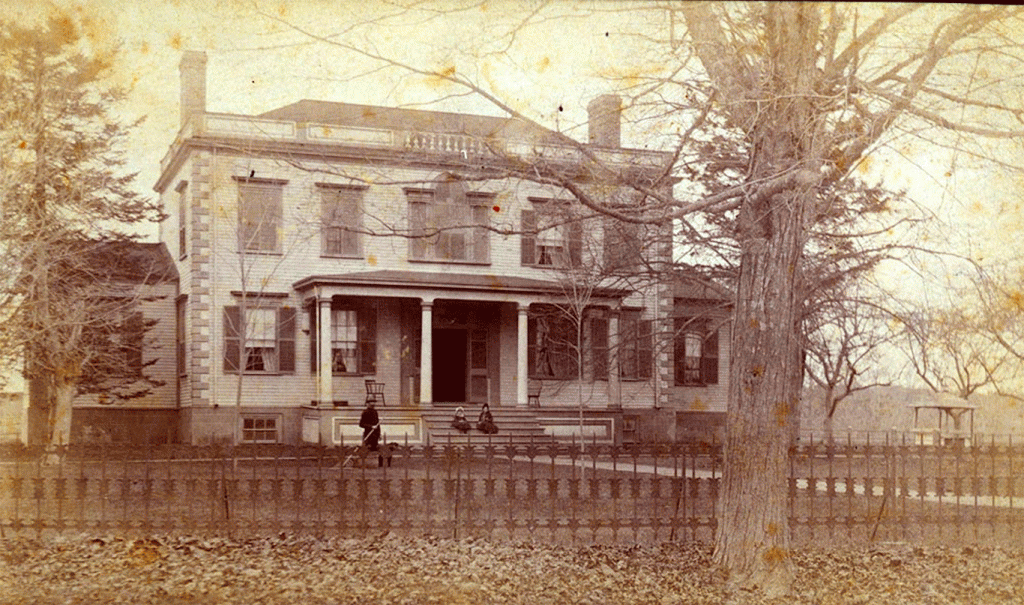
Home of Mrs. John L. Sill, ca. 1885. LHSA
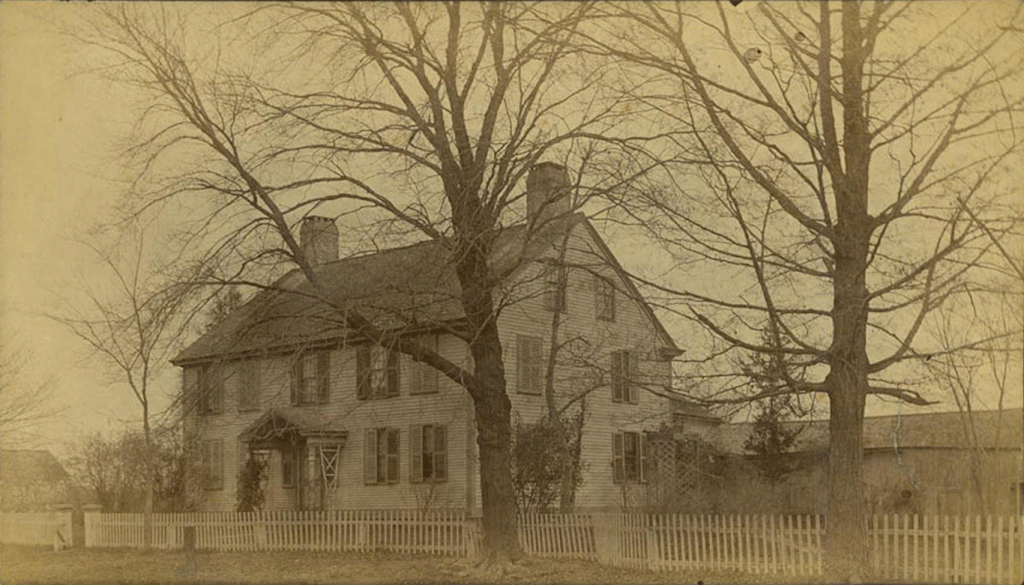
Home of Mrs. William Noyes, ca. 1890. LHSA
An inventory of John L. Sill’s (1787-1852) personal property lets us glimpse the surroundings in which women read together when his wife Abigail entertained. Among her household possessions were four gilt-framed mirrors, one sideboard, one tea table, one dining table with ends, twenty three chairs, one case of drawers, two globes, one carpet, one china dining set, one tea set, one set of china jars, one clock, one trunk of linens, plus her monogrammed silver marked “ALN.” Her barn held a sleigh and a horse cart.[3]
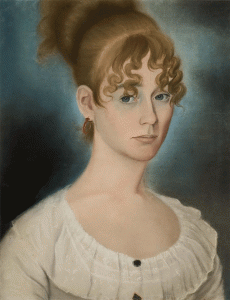
James Martin, Abigail Leverett Noyes, ca. 1798. Pastel on paper. Pastel on paper. Florence Griswold Museum, purchase with contributions from Geoffrey Paul, David Dangremond, John and Werneth Noyes, and Gay Myers
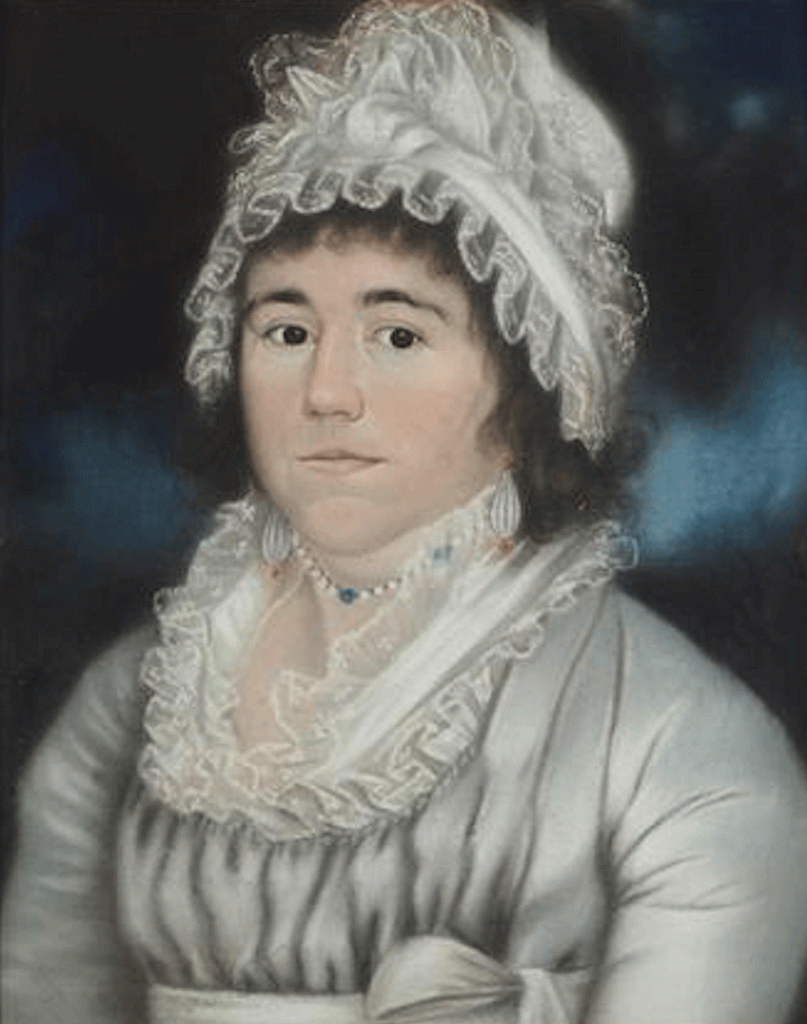
James Martin, Mary Ann Noyes, ca. 1798. Pastel on paper. Private collection
More than a decade later when the Society revised its constitution in 1828, Mrs. Lord had succeeded the first president Mrs. Mary Ann Noyes (1768-1819), whose spacious home is now the Bee and Thistle Inn. Membership had increased to 22, and that year the group decided to meet “at the house of some member of this Society every Wednesday between the hours of 2 & 4 PM, read a portion of the holy scriptures and any other book whose tendency is to elevate the mind and improve the heart, and our meeting to begin and end with prayer.”[4] The Society’s notebook doesn’t tell us what texts the women chose besides the Bible, but the libraries of Lyme residents in the early 19th century contained many more religious tracts, sermons, and meditations than books on any other subject.[5]

Attributed to Charles Parsons, “The Waite Mansion,” Harper’s New Monthly Magazine, February 1876. LHSA
Records of the Female Reading Society are incomplete, but one of the last notebook entries states that Mrs. Maria Selden Waite (1791-1866), who had hosted several meetings in her Lyme Street home, became the third president after Mrs. Lord’s death in 1841. By then the wave of evangelism known as the Second Great Awakening, which roused religious passions especially among women, had passed.[6] Instead of sharing devotional books to “elevate the mind and improve the heart,” the renamed Congregational Church Ladies Society sewed for the needy and raised funds to help refurbish the stately Meetinghouse and maintain the local burying ground. They also planned elaborate fairs and musical performances that provided entertainment for the community while generating funds for the church.[7] Almost half a century would pass before females in 1885 were allowed to voice opinions and vote at church meetings, but the Reading Society had paved the way for women’s increasingly public and independent role.[8]
[1]Female Reading Society notebook, 1816. The cover indicates that the notebook had previously been used in 1802 as a Day Book, or journal, likely by Mrs. Phoebe Lord. LHSA
[2]Female Reading Society notebook, 1817, 1818. LHSA
[3]Inventory of John L. Sill, 1820. Ely-Plimpton Papers, Noyes Collection, LHSA
[4]Female Reading Society notebook, 1828. LHSA
[5]A list of titles of all books on theology, philosophy and religion inventoried in Lyme libraries from 1780-1800 appears in Minor Myers, Jr., “Letters, Learning, and Politics in Lyme: 1760-1800.” See George J. Willauer, Jr., A Lyme Miscellany, 1776-1976 (Middletown, CT, 1977), pp. 71-78.
[6]Mrs. Phoebe Lord’s younger brother Rev. Edward Dorr Griffin, (1770-1837), a prominent minister and early evangelist in New England who became president of Williams College, encouraged her religious convictions and likely influenced the thought of Rev. Lathrop Rockwell. See Mark Rogers, Edward Dorr Griffin and the Edwardsian Second Great Awakening (PhD dissertation, Trinity International University, 2012; abstract).http://gradworks.umi.com/35/05/3505854.html
[7]Gertrude McCurdy Lord (1840-1904) diary, Lord Papers, LHSA; Phoebe Griffin Noyes (1797-1875) to her children (February 22, 1864), Charles Phelps Noyes Papers, LHSA.
[8] For the critical role women played in the Second Awakening and the establishment of women’s organizations that linked personal piety and social action, see Susan Hill Lindley, You Have Stept Out of Your Place: A History of Women and Religion in America (Louisville, 1996), pp. 60 ff. For women’s inclusion in church meetings, see Susan Hollingsworth Ely and Willis Umberger, et al., History of the First Congregational Church of Old Lyme, Connecticut, 1665-1993 (Old Lyme, 1993), p. 108.

